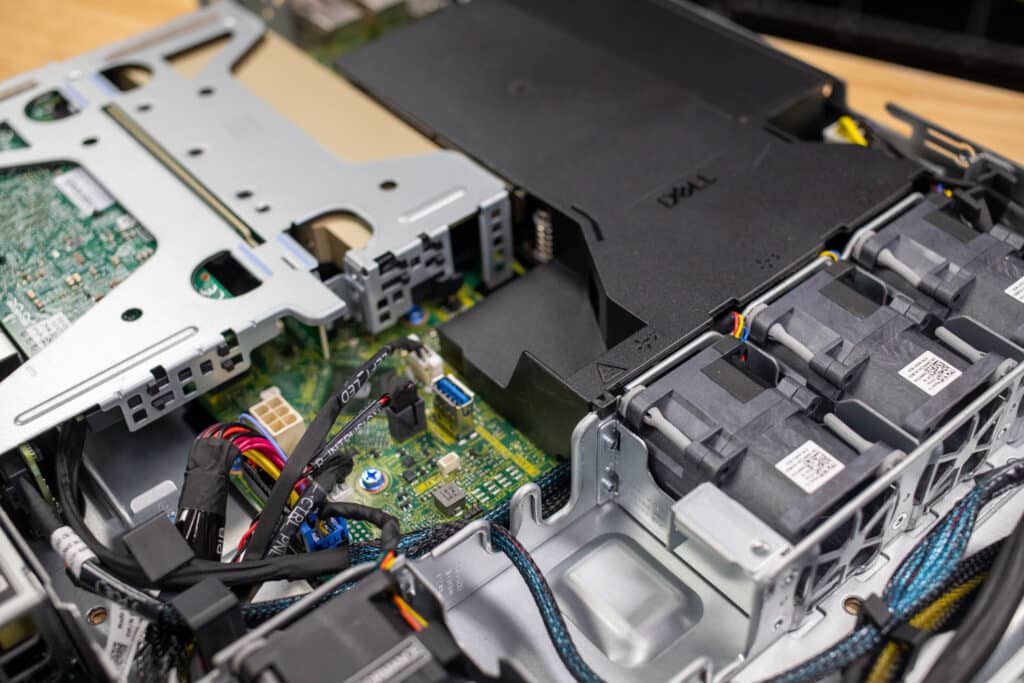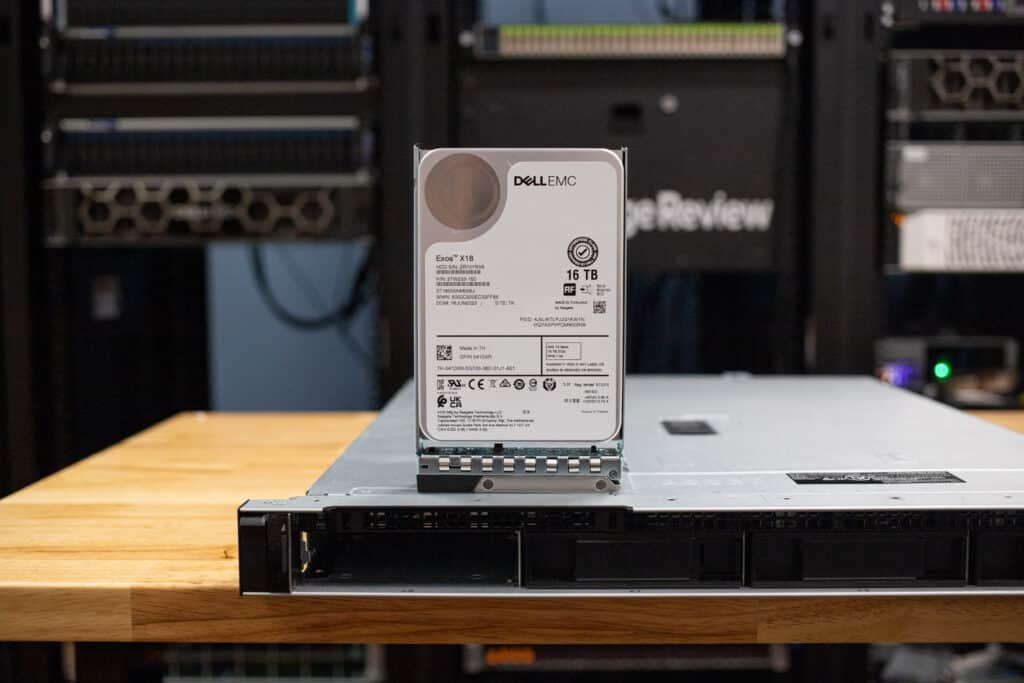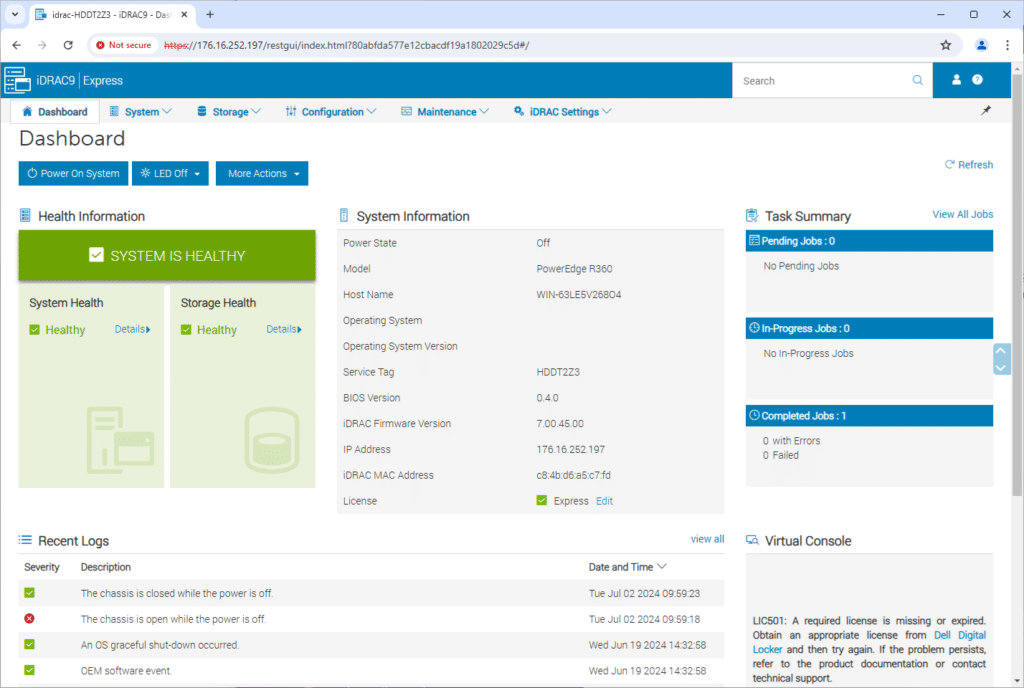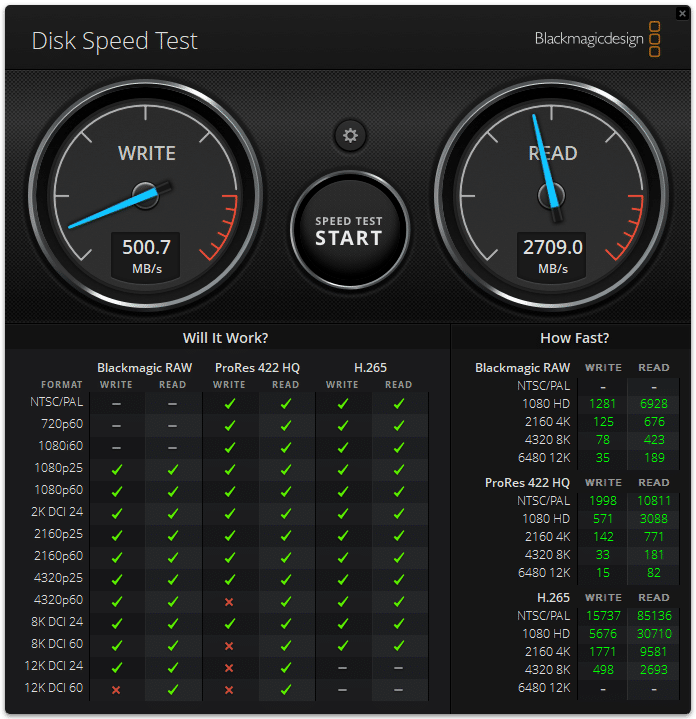The Dell PowerEdge R360 is a 1U, single-socket Intel Xeon E-2400 rack server with DDR5 and PCIe Gen5, for near-edge and SMB applications.
The PowerEdge R360 is a 1U, single-socket rack server for near-edge and SMB applications. It is intended to deliver maximum value and is powered by Intel Xeon E-2400 series processors, DDR5 memory, and PCIe Gen5 support.

The PowerEdge R360 improves over the preceding PowerEdge R350 by offering a more powerful CPU, greater memory bandwidth, superior boot storage (BOSS N-1 versus BOSS S-2), and support for one 40-60W NVIDIA A2 entry data center GPU. (The PowerEdge R350 didn’t support GPUs.)
The PowerEdge R360 supports four 3.5-inch or eight 2.5-inch drives and two PCIe Gen5 slots for storage and expansion. The tower version of this server, 4.5U PowerEdge T360, offers more storage with eight 3.5-inch drives and four PCIe slots (three Gen4 and one Gen5). The PowerEdge R360 also offers two hardware RAID options, leveraging the PERC H355 or H755 through a dedicated riser.

Dell PowerEdge R360 Specifications
| Processor | One Intel Xeon E-2400 series processor with up to 8 cores or One Intel Pentium G7400/G7400T processor with 2 cores |
| Memory |
|
| Storage Controllers |
|
| Drive Bays | Front bays:
|
| Power Supplies |
|
| Cooling Options | Air cooling |
| Fans | Up to 4 fans |
| Dimensions |
|
| Form Factor | 1U rack server |
| Embedded Management |
|
| Bezel | Security bezel |
| OpenManage Software |
|
| Mobility | OpenManage Mobile |
| OpenManage Integrations |
|
| Security |
|
| Embedded NIC | 2x 1GbE LOM |
| Ports | Front Ports
Rear Ports
Internal Ports:
|
| PCIe |
|
| Operating System and Hypervisors |
|
Dell PowerEdge R360 Design
The PowerEdge R360 is a 1U rack server with standard dimensions (1.68 by 18.97 by 24.57 inches [HWD, with bezel]). Front ports include a Micro-AB USB port for iDRAC Direct and one USB 2.0. A security bezel to prevent access to these ports is optional.
Around the back is a dedicated iDRAC Ethernet jack, another USB 2.0, one USB 3.2 Gen1, and VGA and Serial ports. Internally, the PowerEdge R360 has a single USB 3.2 Gen1 port. Also visible back here is the BOSS-N1 slot for dedicated M.2 boot drives, which means regular storage doesn’t need to be used for this purpose. The server’s twin power supplies are also visible from the rear; it sports a pair of 600W Platinum or 700W Titanium hot-swap redundant units.
Looking inside, the PowerEdge R360’s basic layout puts the CPU at the rear; even the top-end Xeon E-2488 makes do with a passive cooler. The CPU has a TDP of just 95 watts. Four DDR5 DIMM slots to its left supports 128GB of RAM (4x 32GB). Registered (ECC) memory is not supported. The twin PCIe expansion slots are next to the CPU heatsink.
Four simple-swap fans along the centerline provide air cooling. The airflow shroud inside the chassis directs air across the CPU, although it does have a single cutout to direct air across installed PCIe hardware.
The drive bays are ahead of these; the PowerEdge R360 accommodates four 3.5-inch or eight 2.5-inch bays. Dell offers several RAID controllers and RAID 0, 1, 5, 6, or 10 configurations from the factory.
Dell PowerEdge R360 Versus PowerEdge R260
The PowerEdge R360 is essentially a full-size version of the short-depth PowerEdge R260. Both these servers are intended for near-edge and SMB applications.
Dell also sells tower versions of these servers; the PowerEdge T360 (for which we’ll have a review soon) is the tower version of the PowerEdge R360 and supports additional storage drives and expansion slots. There’s also the lighter-weight PowerEdge T160. These servers all focus on SMB applications and friendly storage options rather than massive amounts of CPU or memory, with one CPU socket and four DIMM slots.
Dell PowerEdge R360 Management and Maintenance
Check out our PowerEdge R260 review for an in-depth look at Dell’s integrated Dell Remote Access Controller (iDRAC). iDRAC provides comprehensive remote management capabilities, allowing administrators to monitor, update, and troubleshoot the server regardless of location.
Dell PowerEdge R360 Performance
We tested the PowerEdge R360 configured as follows:
- Windows Server 2022 Standard
- Intel Xeon E-2488 (8-core/16-thread)
- 128GB DDR5-3600 ECC
- 2x 480GB SSD RAID 1 (OS); 16TB 3.5-inch hard drive
- Nvidia A2 GPU
Our configuration has the most powerful CPU, the maximum amount of memory, and a GPU, so it’s as capable as it can be. Since storage drive configurations can vary widely, most of our testing will focus on the CPU.
In our performance tests, the PowerEdge R360 will compete with the PowerEdge R260, which we tested with the same CPU but half the RAM (64GB). Our other comparable is the PowerEdge T360 tower, which has a more moderate Xeon E-2414 chip (4-core/4-thread) and 32GB of RAM.
Blender 4.0 CPU
Blender is an open-source 3D modeling application. This benchmark was run using the Blender Benchmark utility. The score is samples per minute, with higher being better. Surprisingly, the PowerEdge R260 showed much better performance than the PowerEdge R360. Predictably, the quad-core PowerEdge T360 wasn’t in contention.
| Blender 4.0 (Samples per minute, Higher is better) | Dell PowerEdge R360 | Dell PowerEdge R260 | Dell PowerEdge T360 |
| Monster | 79.07 | 99.64 | 36.93 |
| Junkshop | 53.93 | 66.65 | 23.31 |
| Classroom | 40.87 | 51.19 | 18.75 |
Blackmagic RAW CPU Speed Test
We have also started running Blackmagic’s RAW speed test, which tests video playback. These servers likely wouldn’t be used for video playback, but the PowerEdge R260 again proved faster than the PowerEdge R360 here.
| Blackmagic RAW Speed Test (Higher is better) | Dell PowerEdge R360 | Dell PowerEdge R260 | Dell PowerEdge T360 |
| 8K CPU | 50 fps | 65 fps | 23 fps |
7-Zip Compression
The built-in memory benchmark in the popular 7-Zip utility shows a closer delta between the PowerEdge R360 and the PowerEdge R260, though the latter still had the edge. The PowerEdge T360 was again nowhere close, with a vastly inferior CPU.
| 7-Zip Compression Benchmark (Higher is better) | Dell PowerEdge R360 | Dell PowerEdge R260 | Dell PowerEdge T360 |
| Current CPU Usage | 1,366% | 1,336% | 330% |
| Current Rating/Usage | 4.999 GIPS | 5.892 GIPS | 8.894 GIPS |
| Current Rating | 68.279 GIPS | 78.716 GIPS | 29.364 GIPS |
| Resulting CPU Usage | 1,361% | 1,342% | 331% |
| Resulting Rating/Usage | 5.035 GIPS | 5.871 GIPS | 8.885 GIPS |
| Resulting Rating | 68.504 GIPS | 78.809 GIPS | 29.430 GIPS |
| Decompressing | |||
| Current CPU Usage | 1,597% | 1,591% | 394% |
| Current Rating/Usage | 4.371 GIPS | 5.470 GIPS | 7.340 GIPS |
| Current Rating | 69.791 GIPS | 87.013 GIPS | 28.925 GIPS |
| Resulting CPU Usage | 1,575% | 1,569% | 397% |
| Resulting Rating/Usage | 4.401 GIPS | 5.451 GIPS | 7.317 GIPS |
| Resulting Rating | 69.321 GIPS | 85.517 GIPS | 29.062 GIPS |
| Total Rating | |||
| Total CPU Usage | 1,468% | 1,456% | 364% |
| Total Rating/Usage | 4.718 GIPS | 5.661 GIPS | 8.101 GIPS |
| Total Rating | 68.912 GIPS | 82.163 GIPS | 29.246 GIPS |
Blackmagic Disk Speed Test
We run the popular Blackmagic Disk Speed Test against the system’s BOSS RAID1 boot SSD.
UL Procyon AI Computer Vision
UL’s Procyon estimates a workstation’s performance for professional apps. Though this test ideally runs on a GPU, we run it once on the CPU for our server reviews. The PowerEdge R360 did as well as could be expected, perhaps edging ahead of the PowerEdge R260 since it has more RAM.
| UL Procyon Average Inference Times (ms, lower is better) | Dell PowerEdge R360 | Dell PowerEdge R260 | Dell PowerEdge T360 |
| MobileNet V3 | 1.02 | 1.10 | 1.46 |
| ResNet 50 | 13.85 | 14.90 | 17.70 |
| Inception V4 | 39.35 | 44.42 | 52.38 |
| DeepLab V3 | 40.29 | 46.80 | 58.16 |
| YOLO V3 | 106.94 | 117.50 | 141.53 |
| Real-ESRGAN | 4,280.9 | 4,617.6 | 5,740.2 |
| Overall Score | 107 | 97 | 79 |
y-cruncher
y-cruncher is a multi-threaded and scalable program that can compute Pi and other mathematical constants to trillions of digits. Since its launch in 2009, it has become a popular benchmarking and stress-testing application for overclockers and hardware enthusiasts. These servers aren’t ideal for CPU-heavy applications, but the PowerEdge R360 did respectably enough for its eight-core CPU.
| y-cruncher (Total computation time in seconds; lower is better) | Dell PowerEdge R360 | Dell PowerEdge R260 | Dell PowerEdge T360 |
| 1 billion digits | 40.723 | 35.118 | 68.036 |
| 2.5 billion | 116.892 | 100.2 | 192.715 |
| 5 billion | 259.398 | 220.128 | 426.003 |
| 10 billion | 561.962 | N/A | N/A |
| 25 billion | 1,561 | N/A | N/A |
Geekbench 6
Geekbench 6 is a cross-platform benchmark that measures overall system performance. The Geekbench Browser allows you to compare any system to it. The single-core scores were close between all the units, though the PowerEdge R260 won out in multi-core, as we’ve come to expect.
| Geekbench 6 (Higher is better) | Dell PowerEdge R360 | Dell PowerEdge R260 | Dell PowerEdge T360 |
| CPU Single-Core | 2,471 | 2,747 | 2,314 |
| CPU Multi-Core | 12,934 | 14,384 | 7,380 |
Cinebench R23
This benchmark uses all CPU cores and threads to generate an overall score. The outcome here was similar to what we saw in Geekbench 6.
| Cinebench R23 (Higher is better) | Dell PowerEdge R360 | Dell PowerEdge R260 | Dell PowerEdge T360 |
| Multi-Core | 12,743 | 16,056 | 6,525 |
| Single-Core | 1,772 | 2,000 | 1,669 |
Cinebench 2024
We also started running the latest Cinebench test. The results here are similar to those in Geekbench 6.
| Cinebench R23 (Higher is better) | Dell PowerEdge R360 | Dell PowerEdge R260 | Dell PowerEdge T360 |
| Multi-Core | 724 | 898 | 380 |
| Single-Core | 103 | 117 | 98 |
Conclusion
Dell’s PowerEdge R360 is a promising value for SMB and near-edge applications thanks to its affordable components and versatile configurations. The most significant improvement over the PowerEdge R350 is its ability to house a single NVIDIA A2 GPU, which broadens its appeal to AI applications. It also improves on its predecessor with a faster Xeon CPU, superior memory bandwidth, and a more advanced BOSS N-1 storage drive configuration for the operating system.
As always, Dell includes its popular and easy-to-use iDRAC management software. A short-depth version of this server, the PowerEdge R260, is also available, as is a tower version (PowerEdge T360) that supports more expansion. The PowerEdge R360 offers commendable value for SMBs seeking a lightweight, value-oriented server.
Dell PowerEdge R360 Product Page
Engage with StorageReview
Newsletter | YouTube | Podcast iTunes/Spotify | Instagram | Twitter | TikTok | RSS Feed








